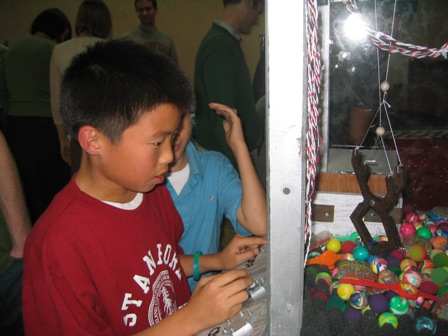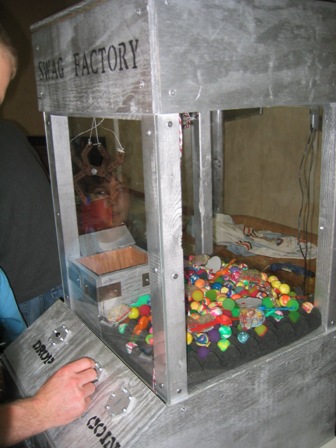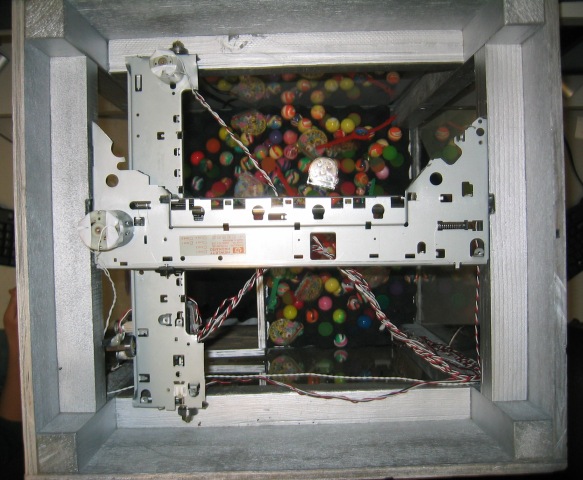Meet the Swag Factory Engineers top
We are Caitlin Donhowe, Amy Askin, and Alan Sledd.
Caitlin is a trophy wife who loves cooking, sewing, laundry, cleaning, and finite element modeling.
Amy is a first-year Ph.D. student in CEE. She grew up in Tucson, Arizona but she loves the much cooler weather out here. She like cooking, scrapbooking, and playing whatever random sports she comes across.
Alan is a mechanical engineer who has managed to avoid the bulk of electronics until now. He is taking 218 because his coworkers at Tesla Motors unintentionally but constantly make him feel like a clown for this. He is lousy at basketball, swimming, and fluid dynamics but pretty good at everything else.
About the Challenge top
Each Mechatronic Penny Arcade Game (MPAG) must pay homage in spirit to games that you would find in a traditional penny arcade. Concepts may be old or new, traditional or contemporary, conservative or cutting-edge – but the experience of interacting with them must be reminiscent of a penny arcade experience. All MPAGs will involve interaction between the player and the MPAG.
In the context of this project, the term “game” is intended to be a very general one. Conventional penny arcade games came in a great variety, from traditional challenges like pinball or miniature bowling, to feats of strength, endurance, or eye-hand coordination, to fortune telling. You need not create a “game” in the strict sense of the word – the overall goal is to devise an interactive experience that players find enjoyable, entertaining, rewarding and/or amazing.
For those not familiar with penny arcades, they were a pre-modern-electronics-era version of video arcade games, with a generous dose of edgy carnival atmosphere. The objective of penny arcades was to attract and entertain players – and to pry as many pennies loose from those customers as possible. Ideally, this is achieved by providing
Click here for the entire project description.
Functionality top
The Swag Factory is designed to closely replicate the experience of a carnival claw machine. After placing a penny in the coin slot, the user is given 20 seconds to position the claw in the horizontal plane and push the drop button. The claw will then drop, close, rise, return to the start position, and open. If the user is lucky (or skilled), the claw will grasp a prize when it closes. That prize is then dropped in the chute and the user can reach in to grab their prize. For this construction, 1 inch diameter bouncy balls, small puzzle watches, and mini-pinball games were used as prizes.

The machine is simple to use, eliminating the need for all but the most basic instructions. An opto-interrupter is used to sense the insertion of a coin. A two-potentiometer joystick is used to provide analog speed and direction input for the x-y plane. The user drops the claw by pushing a button, activating a momentary switch. When the user inserts a hand into the chute to retrieve a prize, an IR light emitting diode and phototransistor pair senses the hand (by detecting the break in the IR beam between them). When a hand is sensed, a CD player is triggered to play music to celebrate the user’s success.

The claw is able to move in three dimensions and can also open and close. Two printer carriages, one mounted to the other, provide the x-y motion of the claw. The motors’ duty cycle and direction is based on analog joystick input. The vertical motion is provided by two motors attached to spools. These spools wind and unwind the claw’s tethers. The claw is designed to open or close based on which tether is pulled taut. The design also incorporates limit switches on each wall and each claw tether to prevent motor stall and vertical drift over the course of multiple games.


In our testing experience, the claw successfully picks up a prize approximately one-third of the time. This provides a challenging but winnable game for the user.
Click here to
see a video of the Swag Factory in action.
Project Costs top
| Source | Item | Quantity | Cost |
| Home Depot | Electrical Tape | 1 | $3.98 |
| Spray Paint | 2 | $7.58 | |
| Wood Glue | 1 | $0.77 | |
| TA Office | Wire | 36' | $3.60 |
| Diodes | 8 | $1.20 | |
| Motor Driver | 2 | $5.50 | |
| Coin Sensor | 1 | $1.00 | |
| TAP Plastics | Acrylic | $51.96 | |
| Minton Lumber | Masonite | $1.08 | |
| Hobby Engineering | Motors | 2 | $12.00 |
| Dycem | Dycem | $0.62 | |
| Digikey | Micro Switches | 6 | $6.22 |
| Joystick | 1 | $5.40 | |
| Etc. (Preowned) | Assorted Electronics | $15.00 | |
| Total | $145.91 | ||